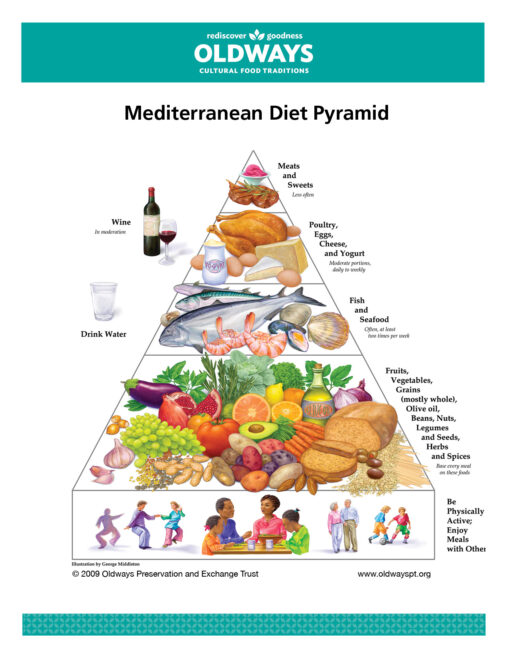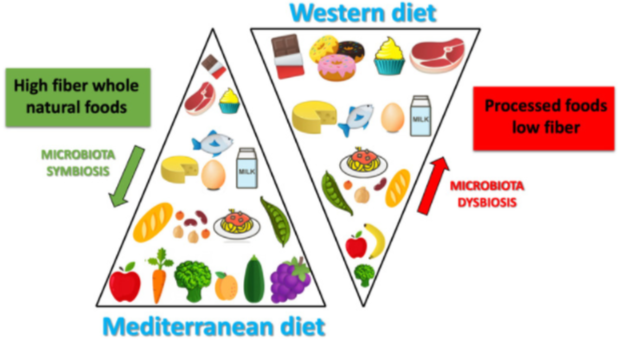Unlock the secrets behind this healthy, traditional diet from the Mediterranean region with our guide to the Mediterranean Diet Pyramid!
The Mediterranean Diet Pyramid was developed by Oldways in 1993 as a healthier alternative to the USDA’s original food pyramid. This diet is based on the healthy eating habits of people who live near the Mediterranean Sea, and it combines nutrient-rich foods from all the major food groups – fruits and vegetables, whole grains, legumes, lean proteins, seafood and healthy fats like olive oil.
This post contains some affiliate links to products that I use and love. If you click through and make a purchase, I’ll earn a commission, at no additional cost to you. Read my full disclosure here.
This pyramid highlights a variety of healthy and delicious ingredients that provide balanced nutrition while still allowing you to enjoy meals with your family. With each additional serving of fruits and vegetables, grains, legumes, lean proteins, seafood or healthy fats you get, your body gets an array of nutrients essential for health.
The Mediterranean Diet is more popular than ever and new studies continue to document its benefits. By following this diet and focusing on fresh ingredients rich in vitamins A, C and E as well as antioxidants such as carotenoids highlighted in the Mediterranean Diet Pyramid, you can make sure you’re getting balanced nutrition every day!

What Is The Mediterranean Diet Pyramid?
he Mediterranean Diet Pyramid is a visual guide featuring the ratio of food groups recommended for consumption in the Mediterranean diet.
The pyramid recommends that you eat more of certain food groups such as fruits and vegetables, beans and legumes, nuts and seeds, whole grains and unrefined oils. Dairy products, eggs and meat are consumed in moderation while sweets are eaten sparingly.
The graphic provides information on the health benefits associated with each food group, as well as tips to help you plan meals. It is important to note that no single food should make up your meals – by eating a variety of foods from all areas of the pyramid, you can get all of your essential nutrients for good overall health.
Read our review on the Mediterranean Diet Plan and take the 30 day challenge to reach your weight loss and health goals. Click here to read.
How Does It Differ From The USDA Food Pyramid?
The main difference between the USDA pyramid and the Mediterranean Diet Pyramid is its focus on plant-based foods such as fruits and vegetables, whole grains, legumes, nuts, seeds and herbs. It also advocates for moderate amounts of dairy products including yogurt and cheese. Ollive oil is a major component of dietary fat intake, along with moderate consumption of fish or poultry prepared lean or with healthier fats.
Very limited unhealthy red meats such as processed meats are recommended. Eating mainly plant-based proteins like legumes supplemented with fish and small amounts of lean poultry in place of higher fat animal sources are preferred. Smaller portion sizes, minimal refined carbohydrates (starches), minimal added sugars, along with occasional indulgence in red wine as optional part of dietary protocol.

Essentially, this pyramid emphasizes a healthy lifestyle centered around home cooking with flavorful natural ingredients first instead of focusing on reductionism principles downstream that omit foods not found on a standalone list prior to shopping or food preparation.
In addition to its focus on uncomplicated meals made from whole foods involving all food groups without resorting to rationed portions for individual items per day or setting borders around overall serving size expectations for any one meal (unlike many other nutrition guidelines) it also stresses physical activity along side regular ingestion of health-promoting foods rich in antioxidants, phytochemicals, vitamins and minerals which may be seen in regions where people primarily adhere to this way of life.
Ultimately the goal isn’t just losing weight but to guard ourselves from lifestyle diseases and maintain heart health through a diet model that consists mostly plant-based foods utilizing fresh products while learning how to develop proper eating habits that are supported long-term by appropriate culinary techniques such as roasting rather than frying.
Is The Mediterranean Diet Pyramid Still A Good Model To Follow?
Yes, the Mediterranean diet pyramid is still a good model to follow. It emphasizes a healthy lifestyle centered around home cooking with flavorful natural ingredients and encourages physical activity along with regular ingestion of health-promoting foods rich in antioxidants, phytochemicals, vitamins and minerals.
The Mediterranean Diet is based on the dietary patterns of Crete, Greece and southern Italy circa 1960 when chronic disease rates were among the lowest in the world and adult life expectancy was among the highest.
Benefits of Following The Mediterranean Diet
Research suggests that following this diet can promote good health and longevity. This is due to its emphasis on whole grains, fruits and vegetables, healthy fats such as olive oil, fish and seafood, nuts and legumes, moderate amounts of dairy products and red wine (in moderation), and limited amounts of processed foods.
Additionally, physical activity is encouraged as part of a healthy lifestyle. By following these guidelines one can enjoy a balanced diet that is rich in nutrients while still being mindful about portion sizes.
Following the Mediterranean Diet Pyramid will help you:
Improve your overall health by increasing your intake of fruits, vegetables, whole grains, beans and legumes, nuts, seafood (especially fatty fish rich in omega-3 fatty acids), plant-based unsaturated oils such as olive oil;
- Reduce risk factors associated with coronary heart disease;
- Choose healthy fats like olive oil instead of saturated fats from animals;
- Eat fewer refined carbohydrates like white bread or pasta;
- Control portion sizes and calories for weight management;
- Replace red meat with fish or poultry at least twice weekly;
- Decrease butter or cream use and replace with hummus instead;
- Drink moderate amounts of red wine (optional).
Read our review on the Mediterranean Diet Plan and take the quiz to discover how it can hep you reach your weight loss and health goals. Click here to read it now.
The Base: Make These Part Of Your Lifestyle
The base of the Mediterranean Diet Pyramid is made up of fruits, vegetables, whole grains, beans and legumes, nuts, seafood (especially fatty fish rich in omega-3 fatty acids), plant-based unsaturated oils such as olive oil.
These foods form the foundation of a healthy diet and are important for providing essential vitamins and minerals to the body. They also provide fiber which helps to keep you feeling full longer and can help with weight management.
Eating these foods regularly can help reduce risk factors associated with cardiovascular disease and other chronic diseases.
Mediterranean Diet Recipes & Other Resources
The resources below will help you make the most of your diet. All links are affiliate links, which means we get a commission if you buy through our link.
For more information, visit the Amazon Mediterranean Store where you will find recipes, cookbooks, and general information on how to eat healthy.
To get the most out of a Mediterranean Diet, take the quiz to get personalized information on how to use the diet to reach your goals and lose weight. Click here to take the quiz.

